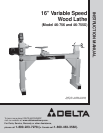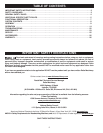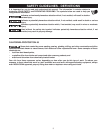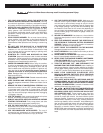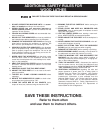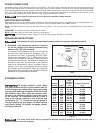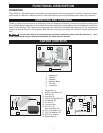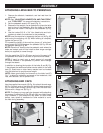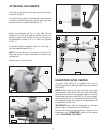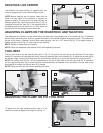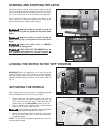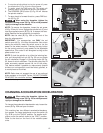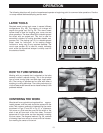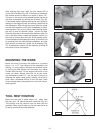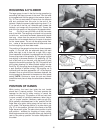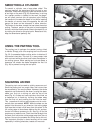
6
POWER CONNECTIONS
A separate electrical circuit should be used for your machines. This circuit should not be less than #12 wire and should be protected
with a 20 Amp time lag fuse. If an extension cord is used, use only 3-wire extension cords which have 3-prong grounding type plugs
and matching receptacle which will accept the machine’s plug. Before connecting the machine to the power line, make sure the switch
(s) is in the “OFF” position and be sure that the electric current is of the same characteristics as indicated on the machine. All line
connections should make good contact. Running on low voltage will damage the machine.
Do not expose the machine to rain or operate the machine in damp locations.
Delta Models 46-756 and 46-755X are wired for 230 volt, 50/60 HZ alternating current and provide a no-load spindle speed of 0-
3000 RPM. Before connecting your machine to the power source, place the switch in the “OFF” position.
NOTE: The specifications on the motor will read “230 volt-3 phase”. This is correct and is accomplished with a high frequency
inverter.
IMPORTANT: The motor cannot be run without the inverter.
NOTE: The power supply to the inverter is 230 volt, single phase.
Do not change the input voltage. To do so will cause severe damage to the inverter.
GROUNDING INSTRUCTIONS
This machine must be grounded while in use to protect the operator from electric shock.
In all cases, make certain that the receptacle in question is properly grounded. If you are not sure, have a
qualified electrician check the receptacle.
3. Grounded, cord-connected machines intended
for use on a supply circuit having a nominal rating
between 150 - 250 volts, inclusive:
If the machine is intended for use on a circuit that has
an outlet that looks like the one illustrated in Fig. C,
the machine will have a grounding plug that looks
like the plug illustrated in Fig. C. Make sure that the
machine is connected to an outlet having the same
configuration as the plug. No adapter is available or
should be used with this machine. If the machine
must be re-connected for use on a different type of
electric circuit, the re-connection should be made
by qualified service personnel. After re-connection,
the machine should comply with the National Electric
Code and all local codes and ordinances.
Fig. C
GROUNDED OUTLET BOX
CURRENT
CARRYING
PRONGS
GROUNDING BLADE
IS LONGEST OF THE 3 BLADES
EXTENSION CORDS
Use proper extension cords. Make
sure your extension cord is in good condition and is a
3-wire extension cord which has a 3-prong grounding
type plug and matching receptacle which will accept
the machine’s plug. When using an extension cord,
be sure to use one heavy enough to carry the current
of the machine. An undersized cord will cause a
drop in line voltage, resulting in loss of power and
overheating. Fig. D-1 shows the correct gauge to
use depending on the cord length. If in doubt, use the
next heavier gauge. The smaller the gauge number,
the heavier the cord.
Fig. D-1
MINIMUM GAUGE EXTENSION CORD
RECOMMENDED SIZES FOR USE WITH STATIONARY ELECTRIC MACHINES
Ampere
Rating Volts
Total
Length of
Cord in
Feet
Gauge of Extension
Cord
0-6 240
up to
50 18 AWG
0-6 240 50-100 16 AWG
0-6 240 100-200 16 AWG
0-6 240 200-300 14 AWG
6-10 240
up to
50 18 AWG
6-10 240 50-100 16 AWG
6-10 240 100-200 14 AWG
6-10 240 200-300 12 AWG
10-12 240
up to
50 16 AWG
10-12 240 50-100 16 AWG
10-12 240 100-200 14 AWG
10-12 240 200-300 12 AWG
12-16 240
up to 50
14 AWG
12-16 240 50-100 12 AWG
12-16 240
GREATER THAN 50 FEET NOT RECOMMENDED
MOTOR SPECIFICATIONS



